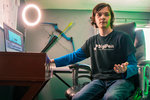



Like many teenagers, Centralia High School senior Andrew Roulst spent a good chunk of the pandemic indoors, socially distanced and playing video games.
But he wasn’t playing those multi-million dollar projects that you’d normally find kids his age engaged with. No, he’s been busy playing something largely his own, something you can’t find on the shelves at big-box stores: “Skyborn.”
"I actually haven't had much time to do anything else," Roulst said from his home during a recent interview with The Chronicle.
"I haven't seen him game in, like, a year," replied his mother, Daulina Roulst.
“Skyborn” is the name of Roulst’s video game concept he’s been working on over the last eight months. And he hasn’t been playing it as much as he’s been building it — coding physics and scenarios, forming and implementing designs and testing and working out the kinks that come with video game development.
Developing his passion project — which stars an unnamed, weasel-like main character tasked with collecting orbs to bring back sacred elemental birds, all of which takes place in a 3D environment — has brought Roulst his own opportunities.
Last month, “Skyborn” took first place at the 2021 SkillsUSA Washington state conference, punching his ticket to showcase it at the national convention. Roulst’s work has led to a $70,000 scholarship opportunity at DigiPen Institute of Technology in Redmond.
"We're over-the-moon proud," Daulina Roulst said. "We always knew he was special, and always had the ability to put his mind to whatever ... I think for us as parents, we knew he was good at it but had nothing to gauge that on. But then, when he gets a scholarship and gets into this school, it's like 'OK, he is the best at this. This is real.'"
And for Roulst, who has long held goals of leading teams of game programmers on projects, he’s ecstatic to be among other creators working on projects collaboratively in one of the nation’s top tech cities.
"I'm really excited to be able to create more projects, learn more about this field and continue to progress," said Roulst, who estimates he’s put in at least a couple hundred hours into his game. "I know where I'm going, I just need to get there."
Cardboard Nintendo Labo gear and Perler bead designs of Pokemon hung from Roulst’s bedroom walls as he presented his game, which he designed in Unreal Engine 4 on a laptop.
“Skyborn,” Roulst says, is still very much a work in progress. But he and another classmate at New Market Skill Center, a Tumwater-based specialist program where he’s been taking classes during his senior year at Centralia, are still hard at work fleshing the project out.
The duo is busy developing a “situational system,” he notes, that will randomly present the player with challenges to overcome, such as enemies. That is kind of like having “a designer almost in the game. We have that feeling that the game is trying to design itself as you play it," Roulst notes.
They’re also working to develop the video game’s story, which is also in its infancy.
Roulst said there are two video games in particular that have motivated him to bring “Skyborn” to completion and driven him to pursue development: “Outer Wilds,” a first-person adventure game that takes place in space, and the ever-popular “The Legend of Zelda: Breath of the Wild.”
"Those two games are very well designed. It's very apparent that everything there was included for a reason ... I feel like there's so many games out there that don't have that design in it," he said.
The intricate plots, unique storytelling mechanics, breathtaking designs and engaging gameplay are all reasons Roulst wants to get involved in the industry.
Getting Involved Early
Although he finished 20 class credits last year online and positioned himself for a relaxing senior year, Roulst wasn’t always an engaged student.
The traditional class model bored Roulst and wasn’t engaging him in any of his interests.
But in third grade, Roulst was introduced to the district’s Highly Capable Program (HiCap), which benefits young students by teaching specialized instruction.
As Roulst described it, the program allowed him to get involved in logic puzzles and with animation programs.
"He's a perfect example of why this program is important," Daulina Roulst said. "He wasn't challenged in grade school ... He kind of didn't learn how to learn."
He eventually got into the world of coding, starting first by learning JavaScript from Khan Academy videos and block programming applications such as Scratch.
Learning those programs only took curiosity and some search engine clicks, mixed in with some time and patience.
"It wasn't that hard because it's a visible programming language ... It was quite simple to look for what I wanted," Roulst said, explaining how he learned Unreal Engine.
His junior year, he took a deep dive into Processing, a “flexible software sketchbook and language for learning how to code within the context of the visual arts,” with the intent of making a video game for a SkillsUSA competition.
Many hours and about 10,000 lines of code later, Roulst finished “Astronint,” his first video game, which was a primitive shooter game that allowed players to build their own ship, battle other vessels and mine planets.
That year’s SkillsUSA competition was unfortunately canceled due to the pandemic. But Roulst said he was proud of what he was able to build regardless — the game had solid bones.
"I love the technology that we put in there," he said.
In February, Roulst applied for DigiPen’s President’s Technology Academy Scholarship, with his application highlighting the work he did in “Skyborn.”
He recently heard back that he would be awarded the scholarship, which will cover half his tuition as he pursues a bachelor’s of science degree in computer science and game design. Roulst said he plans on starting classes this fall.
“I think he’s set up to question the status quo and really be innovative,” said Mike Stratton, Centralia High School’s CTE director and the school’s assistant principal.
Stratton said educators need to maximize their ability to “mass customize education” to meet students at a point where both parties are engaging thoroughly in the curriculum. Roulst, Stratton says, is just one example of those successes they’ve had with a tailor-made approach.
“What impresses me is the project, the thought he put into it and the learning that he put into it,” Stratton said, adding later: “I’m not surprised that he took first place (at SkillsUSA), but I am surprised at the learning that he put into it and his ability to articulate it.”
Roulst presented “Skyborn” and its mechanics to district staff on a video conferencing call recently. The recorded video can be found online at https://bit.ly/3tGx55S